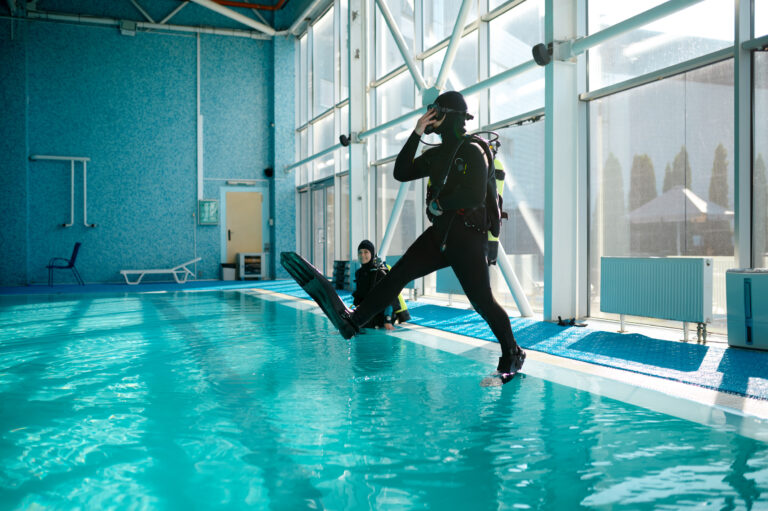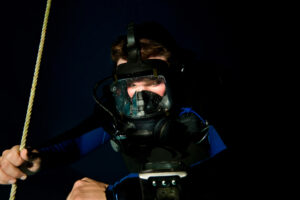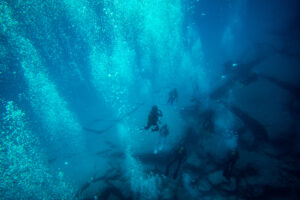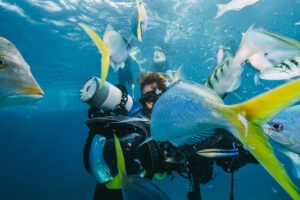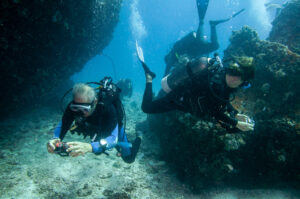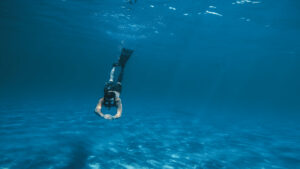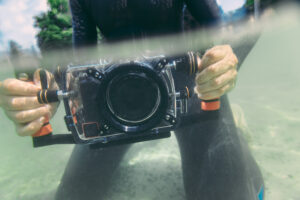What is a Lanyard?
A lanyard in the context of scuba diving is a crucial accessory designed to secure various pieces of diving equipment to a diver’s body or buoyancy compensator device (BCD). These cords, straps, or retractable reels ensure that essential tools such as cameras, flashlights, and dive computers remain attached to the diver, preventing accidental loss in the underwater environment. The importance of a lanyard cannot be overstated, as it contributes significantly to the safety and efficiency of diving operations, providing peace of mind and allowing divers to focus on their underwater activities.
Historical Background
The term “lanyard” has its roots in maritime history, originating from the French word “lanière,” which means a strap or thong. Historically, lanyards were used by sailors to secure various tools and weapons, preventing them from falling overboard. These early uses of lanyards were essential for maintaining order and safety on ships, a necessity that translated well into the world of scuba diving.
The transition of lanyards from general maritime use to specific applications in scuba diving began in the mid-20th century, as recreational and professional diving became more popular. Divers recognized the need for reliable methods to secure their equipment, leading to the adaptation of lanyards for underwater use. Initially, simple ropes and cords were used, but as the diving industry evolved, so did the design and materials of lanyards, making them more durable and functional.
In the early days of scuba diving, lanyards were often improvised from available materials. However, as diving technology advanced, specialized lanyards were developed to meet the specific needs of divers. These innovations were driven by the increasing complexity of diving equipment and the growing demand for more secure attachment methods. Today, lanyards are an integral part of diving gear, reflecting decades of evolution and improvement in design and functionality.
Types of Lanyards Used in Scuba Diving
Scuba diving lanyards come in various types, each designed for specific uses and preferences. One of the most common types is the coil lanyard, made from coiled plastic or rubber. This type of lanyard can stretch significantly, allowing divers to use their equipment freely while keeping it securely attached. Coil lanyards are particularly popular for attaching dive lights and cameras, as their flexibility and extendable nature provide ease of use and accessibility.
Another widely used type is the retractor lanyard, which features a retractable reel mechanism. These lanyards allow divers to pull out their equipment when needed and automatically retract it when not in use, keeping it close to their body and reducing the risk of entanglement. Retractor lanyards are often used for dive computers and gauges, as they provide quick access while minimizing clutter.
Clip lanyards are also prevalent, offering a straightforward design with clips or carabiners at both ends. These lanyards are versatile and can be used to secure a wide range of equipment. Made from durable materials like nylon or stainless steel, clip lanyards are reliable and easy to use, making them a favorite among divers for securing tools and accessories that need to be frequently accessed.
The materials used in lanyard construction are crucial for their effectiveness and durability. Common materials include nylon, rubber, stainless steel, and high-strength plastics. Each material offers different benefits: nylon is lightweight and flexible, rubber provides excellent stretch and resilience, stainless steel ensures corrosion resistance and strength, and high-strength plastics offer a balance of durability and flexibility. Choosing the right type of lanyard and material depends on the specific needs and preferences of the diver, as well as the type of equipment being secured.
Functions and Importance
Lanyards play a vital role in ensuring diver safety by keeping essential equipment secure and within reach. One of the primary functions of a lanyard is to prevent the loss of important tools and accessories. Underwater environments can be unpredictable, and the risk of dropping or misplacing items is significant. By attaching equipment to a lanyard, divers can significantly reduce this risk, ensuring that their tools are always accessible when needed.
In addition to preventing loss, lanyards help manage and organize diving equipment. Divers often carry multiple items such as flashlights, cameras, slates, and knives. Without lanyards, managing these tools can become cumbersome, leading to potential entanglement or misplacement. Lanyards allow divers to attach and secure their equipment in an orderly manner, enhancing overall efficiency and safety during dives.
The ergonomic benefits of using lanyards are also noteworthy. By securing equipment close to the body, lanyards reduce the physical strain associated with carrying and accessing tools. This is particularly important for underwater photographers and videographers who need to handle heavy and bulky camera systems. Lanyards provide a convenient and comfortable way to manage these items, allowing divers to focus on capturing images and videos without worrying about equipment loss or damage.
Furthermore, lanyards contribute to the overall streamlining of a diver’s profile. By keeping equipment close to the body and minimizing dangling items, lanyards help reduce drag and improve maneuverability underwater. This is especially important in strong currents or when navigating through tight spaces. A streamlined profile not only enhances a diver’s comfort and efficiency but also contributes to better air consumption and buoyancy control, essential factors for a safe and enjoyable diving experience.
Safety Considerations
While lanyards offer numerous benefits, it is essential to use them correctly to avoid potential hazards. Improper use or selection of lanyards can lead to entanglement, a significant safety concern for divers. Ensuring that lanyards are of appropriate length and securely fastened can help mitigate this risk. Divers should avoid using excessively long lanyards that may dangle and catch on underwater structures or their own equipment.
Selecting the right lanyard for specific diving activities is crucial. For instance, a retractor lanyard might be ideal for securing a dive computer, while a coil lanyard could be better suited for a camera. Divers should consider the specific requirements of their equipment and the type of diving they will be doing to choose the most appropriate lanyard. Consulting with experienced divers or dive shop professionals can also provide valuable insights into selecting the right lanyard.
Maintenance of lanyards is another important aspect of ensuring their reliability and safety. Regular inspection for signs of wear and tear, such as fraying, corrosion, or weakening of materials, is essential. Lanyards should be rinsed with fresh water after each dive to remove salt and debris, which can degrade the materials over time. Storing lanyards properly, away from direct sunlight and harsh chemicals, will also help prolong their lifespan and maintain their effectiveness.
Divers should be mindful of the placement of lanyards on their gear. Attaching lanyards to secure points on the BCD or harness ensures that equipment remains stable and accessible. Avoiding attachment points that can interfere with essential gear, such as inflator hoses or weight systems, is critical. Proper placement and attachment of lanyards contribute to a streamlined and organized diving setup, enhancing overall safety and convenience.
Innovative Uses and Custom Solutions
In addition to standard uses, many divers have developed innovative ways to utilize lanyards, customizing them to suit specific needs. Professional divers, such as underwater photographers and marine biologists, often require specialized setups to manage their extensive equipment. Custom lanyard solutions, such as adjustable lengths or quick-release mechanisms, provide flexibility and ease of use for these professionals, allowing them to focus on their tasks without worrying about equipment security.
Examples of innovative lanyard designs include multi-attachment systems that can secure several tools simultaneously. These systems often feature multiple attachment points or carabiner clips, allowing divers to carry and manage various pieces of equipment efficiently. For instance, a marine biologist might use a multi-attachment lanyard to secure sample collection tools, a camera, and a slate, ensuring that all essential items are readily accessible and organized.
Future trends in lanyard design and material technology are likely to focus on enhancing durability, functionality, and user convenience. Advances in materials science may lead to the development of more robust and lightweight lanyards, capable of withstanding harsh underwater conditions. Additionally, incorporating features such as adjustable lengths, integrated retractor mechanisms, and ergonomic designs will continue to improve the user experience and safety of divers.
As the diving industry evolves, the demand for customized and innovative lanyard solutions will likely increase. Divers are continually seeking ways to enhance their underwater experiences, and the development of specialized lanyards will play a crucial role in meeting these needs. By staying informed about the latest trends and innovations in lanyard design, divers can ensure that they are using the most effective and reliable equipment available.
Key Takeaways
Lanyards are an essential component of scuba diving gear, providing security, organization, and ergonomic benefits for divers. They have evolved from simple straps to sophisticated tools designed to meet the specific needs of modern divers. Understanding the different types of lanyards, their functions, and safety considerations is crucial for making informed decisions about their use. By selecting and maintaining the right lanyards, divers can enhance their safety and efficiency, ensuring a more enjoyable and successful underwater experience.

